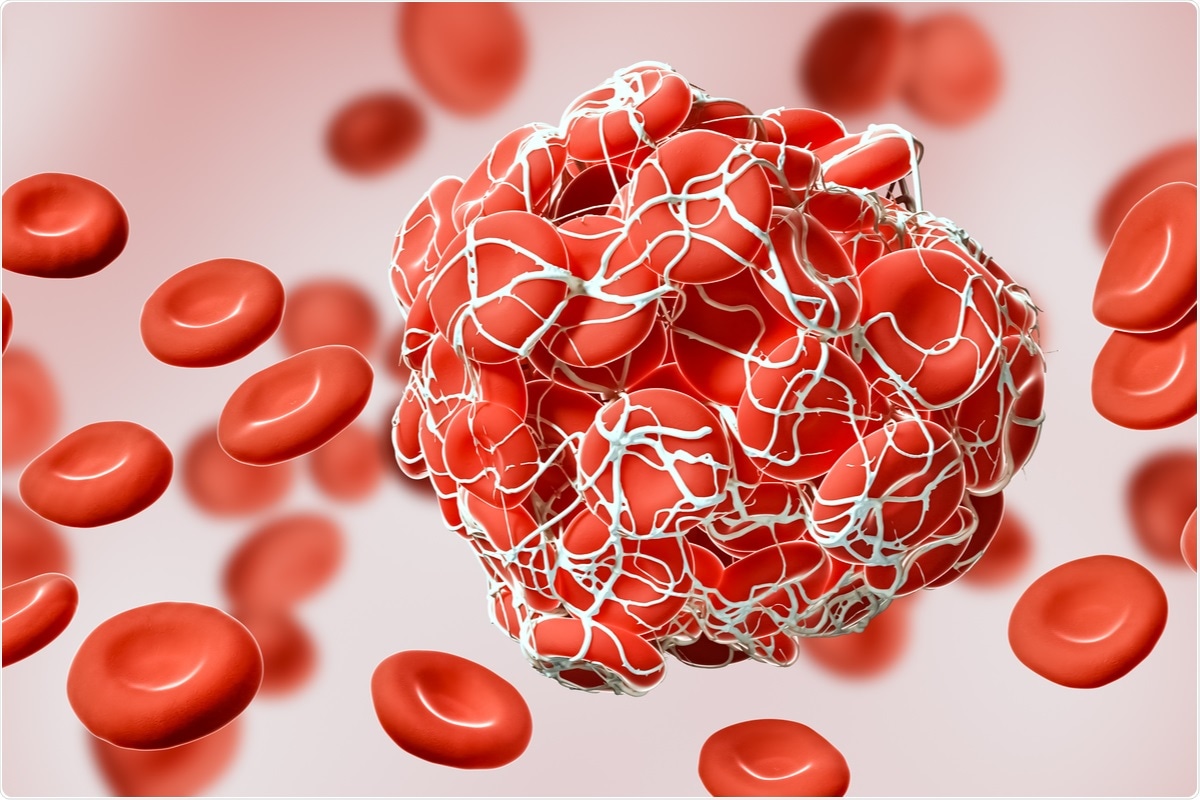The coronavirus disease 2019 (COVID-19), which is caused by infection with the severe acute respiratory syndrome coronavirus-2 (SARS-CoV-2), primarily affects the lower respiratory tract. However, a majority of individuals infected with SARS-CoV-2 either do not develop any symptoms or experience very mild symptoms.

Study: Activation of the Carboxypeptidase U (CPU, TAFIa, CPB2) System in Patients with SARS-CoV-2 Infection Could Contribute to COVID-19 Hypofibrinolytic State and Disease Severity Prognosis. Image Credit: MattLphotography / Shutterstock.com
Background
Approximately 15% of COVID-19 patients develop viral pneumonia and require oxygen support, of which about 5% of patients can develop sepsis, severe acute respiratory distress syndrome (ARDS), and/or multiorgan failure.
Along with respiratory failure, systemic thromboembolic complications are observed frequently in COVID-19 patients due to a dysregulation of the hemostatic balance. These patients are characterized by low antithrombin concentrations, prolonged prothrombin time, mild thrombocytopenia, and elevated fibrinogen.
Elevated levels of plasminogen activator inhibitor 1 (PAI-1) and substantially reduced clot lysis indicate hypofibrinolysis in COVID-19 patients. Increased plasma D-dimer concentrations are also suggestive of plasmin-mediated fibrinolysis resulting from the activation of the coagulation cascade.
The enzyme carboxypeptidase U (CPU) is a potent inhibitor of fibrinolysis. After thrombin or plasmin activates the zymogen procarboxypeptidase U (proCPU), CPU delays efficient plasminogen activation and helps to counteract the progression of fibrinolysis
A new study published in the Journal of Clinical Medicine measured both proCPU and CPU+CPUi over time to determine the impact of SARS-CoV-2 infection on the CPU system. These findings may assist in determining whether CPU plays a role in the hypofibrinolytic state that is observed in COVID-19 patients.
About the study
The current study involved hospitalized patients who were at least 18 years of age and with confirmed SARS-CoV-2 infection. Clinical data, recorded interventions, and information regarding disease severity were collected. Clinically healthy individuals were also included in the study to serve as controls.
Blood samples were collected from the hospitalized patients shortly after hospitalization, who were also monitored periodically until their discharge. For controls, two blood collections were acquired four weeks apart.
Plasma proCPU concentrations, as well as antigen levels of both activated and inactivated CPU (CPU+CPUi), were determined from the collected samples. Routine laboratory parameters of the COVID-19 positive cohort were also determined.
Study findings
A total of 56 SARS-CoV-2-positive patients were included in the current study, of which 38 were male and 18 were female. The average length of the hospital stay was three to 61 days, while the mean age ranged from 29 to 84 years. A total of 32 healthy controls were included in the study, of which 14 had a history of previous SARS-CoV-2 infection, while 18 did not have any prior SARS-CoV-2 exposure.
The results indicated that proCPU or CPU+CPUi antigen levels did not differ among the two control groups. For COVID-19 patients, proCPU levels were lower as compared to controls shortly after hospital admission, while CPU+CPUi antigen levels were significantly higher.
However, proCPU levels increased during the first week of hospital admission and were significantly higher around day 14 as compared to healthy controls. Thereafter, proCPU levels declined and were almost comparable between COVID-19 positive patients and healthy controls at discharge.
The CPU+CPUi antigen levels also increased over time after hospital admission and until day 14. This was followed by a significant reduction in CPU+CPUi antigen levels at discharge that was comparable to levels shortly after admission.
However, CPU+CPUi antigen levels at discharge were higher in COVID-19 patients as compared to controls. Both proCPU and CPU+CPUi antigen levels remained stable for 28 days.
The secondary rise in proCPU levels was higher for critical disease as compared to non-critical disease. Furthermore, the normalization of CPU+CPUi antigen levels was slower in patients with critical disease.
High C-reactive protein (CRP) levels were observed in patients with reduced proCPU levels. A positive correlation between baseline CPU+CPUi antigen levels and duration of hospital stay was observed. CPU+CPUi antigen levels shortly after admission were also reported to positively correlate with disease severity.
Conclusions
The current study found that an increase in both proCPU and CPU+CPUi antigen levels occurs after hospital admission for COVID-19 patients. These CPU changes can lead to fibrinolysis shutdown and increase the risk of thrombosis in COVID-19 patients.
CPU inhibitors can therefore be used as therapeutics to potentially increase the fibrinolytic capacity of COVID-19 patients. Furthermore, CPU+CPUi antigen levels may serve as a biomarker with prognostic value, as they correlate to disease severity and duration of hospitalization.
Limitations
Follow-up of additional hemostasis parameters was not carried out over time. An additional limitation was that patients with asymptomatic SARS-CoV-2 infection were not included in the current study. Lastly, correlations of fibrinolytic activity and CPU-related parameters in patients with severe SARS-CoV-2 infections were not determined.
Journal reference:
- Claesen, K., Sim, Y., Bracke, A., et al. (2022). Activation of the Carboxypeptidase U (CPU, TAFIa, CPB2) System in Patients with SARS-CoV-2 Infection Could Contribute to COVID-19 Hypofibrinolytic State and Disease Severity Prognosis. Journal of Clinical Medicine. doi: 10.3390/jcm11061494. https://www.mdpi.com/2077-0383/11/6/1494